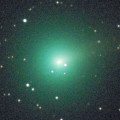
|
Now it is 7.4 mag (Dec. 24, Osamu Miyazaki). It will fade out rapidly after this. It stays observable in good condition.
Date(TT) R.A. (2000) Decl. Delta r Elong. m1 Best Time(A, h)
Dec. 23 11 4.52 14 33.9 0.538 1.264 108 7.2 5:00 ( 0, 69)
Dec. 30 11 26.84 13 22.0 0.525 1.265 110 7.2 4:55 ( 0, 68)
|

|
It returns for the first time in 70 years. It will brighten up to 4.5 mag in spring. It suddenly brightened in major outburst by 5 mag up to 11.5 mag on July 20 (E. Tamas, Francois Kugel). It brightened again in another major outburst up to 9.4 mag on Nov. 15 (Nick James). Now it is 9.4 mag (Dec. 13, Carlos Labordena). It will brighten rapidly after this. In the Northern Hemisphere, it will be unobservable in April. In the Southern Hemisphere, it is not observable now.
Date(TT) R.A. (2000) Decl. Delta r Elong. m1 Best Time(A, h)
Dec. 23 19 13.15 37 46.5 2.363 2.115 63 8.1 18:23 (118, 28)
Dec. 30 19 31.24 37 44.4 2.283 2.025 62 7.9 18:27 (119, 26)
|
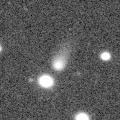
|
It is expected to brighten up to 8.5 mag in early 2024. Now it is 10.7 mag (Dec. 10, Taras Prystavski). Brightening slowly. It locates somewhat low in the Northern Hemisphere. But it will become high in winter. The brightness evolution slowed down since May.
Date(TT) R.A. (2000) Decl. Delta r Elong. m1 Best Time(A, h)
Dec. 23 14 17.90 -39 5.5 1.983 1.540 49 9.8 5:34 (330, 7)
Dec. 30 14 43.23 -38 3.3 1.901 1.491 50 9.6 5:36 (330, 8)
|

|
It is expected to brighten up to 8.5 mag from January to February. Now it is 11.9 mag (Dec. 21, Ken-ichi Kadota). It will turn to fade out rapidly after brightening. It stays observable in good condition.
Date(TT) R.A. (2000) Decl. Delta r Elong. m1 Best Time(A, h)
Dec. 23 2 55.24 14 41.0 0.578 1.452 135 11.7 20:49 ( 0, 70)
Dec. 30 3 2.69 14 25.8 0.588 1.432 129 10.9 20:30 ( 0, 70)
|

|
It approached to Earth down to 0.38 a.u., and brightened up to 8.0 mag in autumn (Sept. 29, Virgilio Gonano). Now it is 12.2 mag (Dec. 22, Osamu Miyazaki). It will fade out rapidly after this. It stays observable in good condition.
Date(TT) R.A. (2000) Decl. Delta r Elong. m1 Best Time(A, h)
Dec. 23 8 57.49 -14 5.2 0.628 1.427 123 10.9 2:54 ( 0, 41)
Dec. 30 8 50.47 -14 33.6 0.652 1.486 129 11.3 2:20 ( 0, 40)
|

|
Now it is 11.8 mag (Dec. 16, Taras Prystavski). Fading slowly. In the Northern Hemisphere, it will be unobservable in January. In the Southern Hemisphere, it will be getting lower gradually. But it will be getting higher again after March.
Date(TT) R.A. (2000) Decl. Delta r Elong. m1 Best Time(A, h)
Dec. 23 23 16.90 -41 48.9 3.635 3.365 66 12.1 18:23 ( 14, 12)
Dec. 30 23 16.86 -41 25.3 3.788 3.419 60 12.2 18:27 ( 20, 10)
|
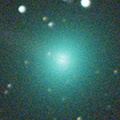
|
It approached to Earth down to 0.2 a.u. in early November, and brightened up to 6.2 mag (Nov. 11, Marco Goiato). Now it is 10.5 mag (Dec. 12, Thomas Lehmann). Fading rapidly. In the Northern Hemisphere, it will be unobservable in January. In the Southern Hemisphere, it will be getting lower gradually. But it will be getting higher again after April.
Date(TT) R.A. (2000) Decl. Delta r Elong. m1 Best Time(A, h)
Dec. 23 22 57.61 -41 53.4 1.422 1.309 62 12.1 18:23 ( 17, 10)
Dec. 30 23 6.80 -42 21.2 1.619 1.394 58 12.7 18:27 ( 21, 9)
|

|
It brightened up to 8 mag from 2022 summer to 2023 spring. Now it is 11.3 mag (Dec. 17, Osamu Miyazaki). Fading slowly. It stays observable in good condition.
Date(TT) R.A. (2000) Decl. Delta r Elong. m1 Best Time(A, h)
Dec. 23 5 46.69 -4 12.1 3.641 4.534 152 12.6 23:39 ( 0, 51)
Dec. 30 5 39.33 -3 15.5 3.715 4.596 150 12.7 23:04 ( 0, 52)
|
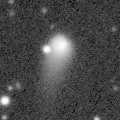
|
It will brighten up to 12 mag from 2024 to 2025. Now it is 13.5 mag (Dec. 25, Giuseppe Pappa). It stays 13 mag for a while. It stays observable in good condition.
Date(TT) R.A. (2000) Decl. Delta r Elong. m1 Best Time(A, h)
Dec. 23 9 20.04 11 7.6 3.643 4.357 131 13.0 3:17 ( 0, 66)
Dec. 30 9 12.27 12 28.4 3.517 4.325 140 12.9 2:42 ( 0, 67)
|

|
Now it is 13.6 mag (Dec. 8, Taras Prystavski). It stays 14 mag for a while. It stays extremely low in the Northern Hemisphere. In the Southern Hemisphere, it stays observable in good condition.
Date(TT) R.A. (2000) Decl. Delta r Elong. m1 Best Time(A, h)
Dec. 23 10 17.23 -40 8.7 4.172 4.338 93 13.2 4:14 ( 0, 15)
Dec. 30 10 7.93 -41 37.5 4.119 4.372 98 13.3 3:37 ( 0, 13)
|

|
Now it is 13.7 mag (Dec. 12, Kunihiro Shima). It will fade out rapidly after this. It will be fainter than 18 mag in February. It stays extremely low.
Date(TT) R.A. (2000) Decl. Delta r Elong. m1 Best Time(A, h)
Dec. 23 15 47.89 -20 5.7 1.796 1.084 31 14.3 5:34 (303, 9)
Dec. 30 16 19.34 -19 43.1 1.798 1.086 31 13.5 5:36 (302, 9)
|

|
Now it is 12.4 mag (Dec. 24, Osamu Miyazaki). It stays observable in good condition.
Date(TT) R.A. (2000) Decl. Delta r Elong. m1 Best Time(A, h)
Dec. 23 8 38.55 20 38.2 5.342 6.164 143 13.6 2:35 ( 0, 76)
Dec. 30 8 35.96 20 44.0 5.283 6.166 151 13.5 2:05 ( 0, 76)
|

|
It brightened up to 7.8 mag in late July (July 20, Thomas Lehmann). Now it is 16.0 mag (Dec. 22, Yukihiro Sugiyama). Fading slowly. It will be getting higher gradually.
Date(TT) R.A. (2000) Decl. Delta r Elong. m1 Best Time(A, h)
Dec. 23 15 16.42 -6 38.7 3.057 2.436 43 13.8 5:34 (298, 24)
Dec. 30 15 16.51 -5 46.1 3.013 2.504 50 13.9 5:36 (303, 30)
|
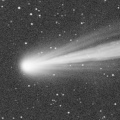
|
It approached to Sun down to 0.23 a.u. and brightened up to 2.5 mag in mid September (Sept. 18, Juan Jose Gonzalez). Now it is 11.8 mag (Dec. 16, Martin Masek). It will fade out rapidly after this. In the Northern Hemisphere, it will be unobservable in January. But it will be observable again in February. In the Southern Hemisphere, it stays observable in good condition. It is brighter than this ephemeris recently.
Date(TT) R.A. (2000) Decl. Delta r Elong. m1 Best Time(A, h)
Dec. 23 12 24.39 -50 1.6 2.245 2.101 68 14.0 5:34 (352, 4)
Dec. 30 12 11.70 -52 11.1 2.248 2.209 75 14.2 5:36 (359, 3)
|

|
Now it is 15.5 mag (Dec. 22, Yukihiro Sugiyama). Brightening slowly. It locates somewhat low in the Northern Hemisphere. In the Southern Hemisphere, it will be getting higher gradually. It is expected to brighten up to 12.5 mag in 2024 spring. At the high light, it will be observable in excellent condition in the Southern Hemisphere, but it will be low in the Northern Hemisphere.
Date(TT) R.A. (2000) Decl. Delta r Elong. m1 Best Time(A, h)
Dec. 23 15 30.04 -16 2.8 3.550 2.820 36 14.1 5:34 (302, 15)
Dec. 30 15 31.23 -17 21.5 3.438 2.800 42 14.0 5:36 (309, 19)
|

|
It brightened up to 8.3 mag in 2021-2022 winter (Jan. 6, 2022, Toshiyuki Takahashi). Now it is 15.7 mag (Dec. 18, ATLAS Chile). It stays 15 mag for a while. It stays extremely low in the Northern Hemisphere. In the Southern Hemisphere, it stays observable in good condition.
Date(TT) R.A. (2000) Decl. Delta r Elong. m1 Best Time(A, h)
Dec. 23 11 28.41 -48 25.1 7.108 6.971 78 14.2 5:25 ( 0, 6)
Dec. 30 11 28.69 -49 19.7 7.078 7.016 82 14.2 4:57 ( 0, 6)
|
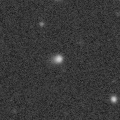
|
It will approach to Sun down to 0.4 a.u. in late September in 2024, and it is expected to brighten up to 0 mag. Now it is 13.9 mag (Dec. 21, Yukihiro Sugiyama). It will brighten rapidly after this. In the Northern Hemisphere, it stays observable in good condition. In the Southern Hemisphere, it will be getting higher gradually. At the high light, in the Northern Hemisphere, it will be observable in good condition after the perihelion passage. In the Southern Hemisphere, it will be observable in the low sky before and after the perihelion passage.
Date(TT) R.A. (2000) Decl. Delta r Elong. m1 Best Time(A, h)
Dec. 23 14 57.02 -6 58.8 4.955 4.350 47 14.4 5:34 (302, 27)
Dec. 30 15 0.31 -7 14.8 4.783 4.271 53 14.2 5:36 (307, 31)
|

|
Now it is 14.9 mag (Dec. 19, ATLAS Chile). It stays 14 mag for a while. It stays extremely low in the Northern Hemisphere. In the Southern Hemisphere, it stays observable in good condition.
Date(TT) R.A. (2000) Decl. Delta r Elong. m1 Best Time(A, h)
Dec. 23 12 3.37 -36 25.1 5.519 5.369 76 14.5 5:34 (355, 18)
Dec. 30 12 6.77 -36 57.5 5.410 5.350 81 14.4 5:35 ( 0, 18)
|
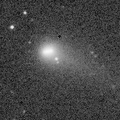
|
Now it is 14.3 mag (Dec. 12, Thomas Lehmann). It stays 15 mag for a while. In the Northern Hemisphere, it stays observable in good condition. In the Southern Hemisphere, it will be getting lower gradually.
Date(TT) R.A. (2000) Decl. Delta r Elong. m1 Best Time(A, h)
Dec. 23 2 42.90 17 54.1 1.491 2.280 133 14.7 20:37 ( 0, 73)
Dec. 30 2 42.30 18 24.3 1.529 2.253 126 14.7 20:09 ( 0, 74)
|

|
It brightened up to 12.1 mag in spring (May 20, Jose Guilherme de S. Aguiar). Now it is 15.0 mag (Dec. 26, ATLAS Chile). Fading slowly. In the Northern Hemisphere, it is not observable now. In the Southern Hemisphere, it stays observable in good condition.
Date(TT) R.A. (2000) Decl. Delta r Elong. m1 Best Time(A, h)
Dec. 23 5 18.09 -85 36.7 3.982 3.776 70 14.7 22:59 ( 0,-30)
Dec. 30 4 25.84 -83 49.5 4.000 3.814 72 14.7 21:45 ( 0,-29)
|
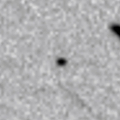
|
It will approach to Earth down to 0.2 a.u. from February to March, and it is expected to brighten up to 13 mag. Now it is 16.7 mag (Dec. 25, ATLAS Chile). It will turn to fade out rapidly after brightening. It stays observable in good condition.
Date(TT) R.A. (2000) Decl. Delta r Elong. m1 Best Time(A, h)
Dec. 23 0 11.78 -13 7.6 0.581 1.115 86 15.3 18:23 ( 5, 42)
Dec. 30 0 23.41 -13 48.3 0.555 1.063 82 15.0 18:27 ( 12, 41)
|
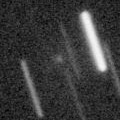
|
Bright new comet. Now it is 15.6 mag (Dec. 21, Katsumi Yoshimoto). It will fade out rapidly after this. It will be fainter than 18 mag in February. In the Northern Hemisphere, it stays observable in good condition. In the Southern Hemisphere, it will never be observable after this.
Date(TT) R.A. (2000) Decl. Delta r Elong. m1 Best Time(A, h)
Dec. 23 13 22.68 44 45.7 1.027 1.462 93 15.2 5:34 (237, 68)
Dec. 30 13 46.98 55 29.9 1.045 1.546 99 15.5 5:36 (212, 64)
|
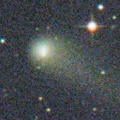
|
It brightened up to 11.1 mag in early 2022 (Mar. 31, 2022, F. Kugel, J.-G. Bosch, J. Nicolas). Now it is 15.5 mag (Dec. 17, A. Diepvens). It stays 15 mag for a while. In the Northern Hemisphere, it will be getting higher gradually. In the Southern Hemisphere, it is not observable now, but it will appear in February.
Date(TT) R.A. (2000) Decl. Delta r Elong. m1 Best Time(A, h)
Dec. 23 16 54.15 16 23.3 6.867 6.186 43 15.2 5:34 (262, 18)
Dec. 30 16 59.90 16 43.9 6.867 6.225 46 15.2 5:36 (265, 23)
|

|
Now it is 15.8 mag (Dec. 13, Ken-ichi Kadota). Fading slowly. It will be unobservable in January in the Southern Hemisphere, or in February in the Northern Hemisphere. But it will be observable again in March in the Northern Hemisphere, or in April in the Southern Hemisphere.
Date(TT) R.A. (2000) Decl. Delta r Elong. m1 Best Time(A, h)
Dec. 23 22 31.26 3 24.4 4.001 3.791 70 15.3 18:23 ( 48, 48)
Dec. 30 22 30.38 3 40.8 4.158 3.825 63 15.4 18:27 ( 57, 43)
|

|
Now it is 15.3 mag (Dec. 25, ATLAS Chile). Fading gradually. It will be fainter than 18 mag in April. In the Northern Hemisphere, it stays observable in good condition. In the Southern Hemisphere, it will be getting lower gradually after this, and it will be unobservable in March.
Date(TT) R.A. (2000) Decl. Delta r Elong. m1 Best Time(A, h)
Dec. 23 0 42.72 -15 10.7 1.427 1.774 92 15.3 18:37 ( 0, 40)
Dec. 30 0 47.60 -10 32.9 1.493 1.774 89 15.4 18:27 ( 4, 45)
|

|
It returned for the first time in 68 years. It will brighten up to 7.5 mag in 2024 summer. Now it is 15.5 mag (Dec. 18, Michael Jager). It will brighten rapidly after this. It stays observable in good condition. At the high light, it locates low in the Northern Hemisphere, or it is not observable in the Southern Hemisphere.
Date(TT) R.A. (2000) Decl. Delta r Elong. m1 Best Time(A, h)
Dec. 23 3 11.54 -17 24.9 2.171 2.814 121 16.1 21:05 ( 0, 38)
Dec. 30 3 4.94 -15 48.1 2.166 2.742 115 15.8 20:31 ( 0, 39)
|
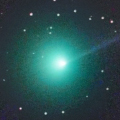
|
It brightened up to 8.1 mag in autumn (Oct. 10, Juan Jose Gonzalez). Fading rapidly. It will be fainter than 18 mag in February. It will never be observable after this.
Date(TT) R.A. (2000) Decl. Delta r Elong. m1 Best Time(A, h)
Dec. 23 18 50.85 -27 34.0 2.245 1.298 11 15.8 18:23 ( 64,-11)
Dec. 30 19 13.37 -26 53.7 2.357 1.397 9 16.4 18:27 ( 66,-12)
|

|
Now it is 16.2 mag (Dec. 16, ATLAS-MLO, Mauna Loa). Fading gradually. It will be fainter than 18 mag in April. In the Northern Hemisphere, it stays observable in good condition. In the Southern Hemisphere, it will be unobservable in March.
Date(TT) R.A. (2000) Decl. Delta r Elong. m1 Best Time(A, h)
Dec. 23 23 22.93 1 25.3 2.032 2.124 81 15.9 18:23 ( 28, 53)
Dec. 30 23 35.17 2 31.2 2.106 2.125 77 15.9 18:27 ( 36, 52)
|
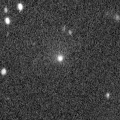
|
Very large comet. It is expected to brighten up to 13 mag in 2031. Now it is 15.9 mag (Dec. 2, Taras Prystavski). It stays 16 mag for a while. In the Northern Hemisphere, it is not observable now. In the Southern Hemisphere, it stays observable in good condition. In the Northern Hemisphere, it is not observable until 2030.
Date(TT) R.A. (2000) Decl. Delta r Elong. m1 Best Time(A, h)
Dec. 23 2 57.46 -65 41.9 16.952 16.881 84 16.0 20:50 ( 0,-11)
Dec. 30 2 55.51 -65 30.0 16.963 16.857 82 16.0 20:21 ( 0,-10)
|

|
New peridic comet which brightened up to 16 mag in 2007. It has not been recovered yet. It was missed in 2013 and 2018. It will approach to Earth down to 0.34 a.u. in winter, and it is expected to brighten up to 16 mag. It will fade out rapidly after this. It will be fainter than 18 mag in February. In the Northern Hemisphere, it stays observable in good condition. It stays extremely low in the Southern Hemisphere.
Date(TT) R.A. (2000) Decl. Delta r Elong. m1 Best Time(A, h)
Dec. 23 21 55.37 14 1.0 0.343 0.913 68 16.0 18:23 ( 69, 51)
Dec. 30 23 6.65 26 22.1 0.337 0.997 82 16.1 18:27 ( 79, 65)
|
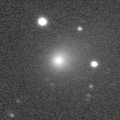
|
It continues to be brightening even after the perihelion passage. Now it is 15.3 mag (Dec. 17, Ken-ichi Kadota). It will fade out rapidly after this. It will be fainter than 18 mag in February. It will be getting lower gradually.
Date(TT) R.A. (2000) Decl. Delta r Elong. m1 Best Time(A, h)
Dec. 23 23 53.79 -15 6.1 3.568 3.569 82 16.1 18:23 ( 11, 39)
Dec. 30 23 59.25 -13 53.5 3.707 3.612 76 16.3 18:27 ( 19, 39)
|

|
Now it is 16.0 mag (Dec. 13, Toshihiko Ikemura, Hirohisa Sato). It stays 16 mag for a while. In the Northern Hemisphere, it will be unobservable in March. In the Southern Hemisphere, it stays observable in good condition. The brightness evolution is slower than originally expected.
Date(TT) R.A. (2000) Decl. Delta r Elong. m1 Best Time(A, h)
Dec. 23 1 51.48 -29 16.9 3.169 3.476 99 16.1 19:45 ( 0, 26)
Dec. 30 1 46.92 -29 47.6 3.238 3.435 93 16.1 19:13 ( 0, 25)
|

|
It has not been observed yet in this apparition. It was expected to brighten up to 15 mag in summer. But actually, it is not detected, fainter than 18 mag (Oct. 14, Martin Masek). Fading slowly. It will be unobservable in January in the Southern Hemisphere, or in February in the Northern Hemisphere.
Date(TT) R.A. (2000) Decl. Delta r Elong. m1 Best Time(A, h)
Dec. 23 21 2.76 -13 35.6 2.599 2.006 43 16.1 18:23 ( 55, 21)
Dec. 30 21 18.37 -12 6.4 2.657 2.016 40 16.2 18:27 ( 59, 20)
|
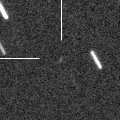
|
Now it is 17.5 mag (Dec. 28, ATLAS-MLO, Mauna Loa). Fading slowly. It will be fainter than 18 mag in April. In the Northern Hemisphere, it will be getting lower gradually. In the Southern Hemisphere, it stays observable in good condition. It is fainter than this ephemeris recently.
Date(TT) R.A. (2000) Decl. Delta r Elong. m1 Best Time(A, h)
Dec. 23 11 34.04 -11 58.9 1.881 2.147 91 16.2 5:30 ( 0, 43)
Dec. 30 11 23.24 -15 45.6 1.784 2.170 99 16.1 4:52 ( 0, 39)
|
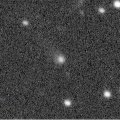
|
Now it is 17.1 mag (Dec. 28, Jean-Claude Merlin). It stays 17 mag for a while. In the Northern Hemisphere, it will never be observable after this. In the Southern Hemisphere, it stays observable in good condition.
Date(TT) R.A. (2000) Decl. Delta r Elong. m1 Best Time(A, h)
Dec. 23 8 57.42 -66 22.1 3.748 3.780 84 16.1 2:54 ( 0,-11)
Dec. 30 8 37.17 -68 36.1 3.742 3.793 85 16.2 2:06 ( 0,-14)
|
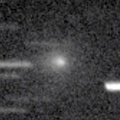
|
It brightened up to 12.6 mag in autumn (Oct. 3, Chris Wyatt). Now it is 17.5 mag (Dec. 7, Toshihiko Ikemura, Hirohisa Sato). Fading rapidly. It will be fainter than 18 mag in January. In the Northern Hemisphere, it stays observable in good condition. It stays extremely low in the Southern Hemisphere.
Date(TT) R.A. (2000) Decl. Delta r Elong. m1 Best Time(A, h)
Dec. 23 22 27.37 2 29.0 1.569 1.531 69 16.2 18:23 ( 48, 47)
Dec. 30 22 52.92 3 36.3 1.679 1.607 68 16.7 18:27 ( 50, 47)
|

|
It brightened up to 13 mag in early 2023. It stays 16 mag for a while. In the Northern Hemisphere, it is not observable now, but it will appear in February. In the Southern Hemisphere, it will be getting higher gradually.
Date(TT) R.A. (2000) Decl. Delta r Elong. m1 Best Time(A, h)
Dec. 23 15 40.54 -48 31.9 4.103 3.376 37 16.2 5:34 (324,-10)
Dec. 30 15 50.35 -48 26.8 4.118 3.435 40 16.3 5:36 (327, -7)
|
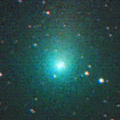
|
It brightened up to 9.5 mag from last winter to early spring (Jan. 30, Katsumi Yoshimoto). Now it is 15.5 mag (Dec. 8, Ken-ichi Kadota). Fading gradually. It will be fainter than 18 mag in March. It will be unobservable in February.
Date(TT) R.A. (2000) Decl. Delta r Elong. m1 Best Time(A, h)
Dec. 23 22 41.61 -13 55.9 4.291 3.997 66 16.2 18:23 ( 32, 35)
Dec. 30 22 45.06 -14 11.6 4.465 4.061 59 16.4 18:27 ( 39, 31)
|
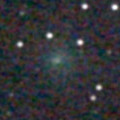
|
Now it is 13.3 mag (Dec. 16, Michael Mattiazzo). Fading slowly. It will be unobservable in January. But it will be observable again in February. It is much brighter than this ephemeris recently.
Date(TT) R.A. (2000) Decl. Delta r Elong. m1 Best Time(A, h)
Dec. 23 21 30.50 -38 36.6 1.340 0.972 46 16.5 18:23 ( 34, 6)
Dec. 30 21 15.52 -38 12.4 1.468 0.913 37 16.4 18:27 ( 41, 0)
|
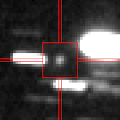
|
It is expected to brighten up to 12.5 mag in 2024 summer. Now it is 17.1 mag (Dec. 20, E. Cortes). Brightening gradually. In the Northern Hemisphere, it is not observable now. In the Southern Hemisphere, it stays observable in good condition. Around the high light, it is observable in good condition in the Southern Hemisphere, but it locates very low in the Northern Hemisphere.
Date(TT) R.A. (2000) Decl. Delta r Elong. m1 Best Time(A, h)
Dec. 23 14 0.20 -57 25.7 4.677 4.186 54 16.6 5:34 (342, -7)
Dec. 30 14 12.17 -58 40.6 4.575 4.131 57 16.5 5:36 (344, -7)
|

|
Now it is 15.9 mag (Dec. 28, ATLAS-MLO, Mauna Loa). It stays 17 mag for a while. It stays observable in good condition.
Date(TT) R.A. (2000) Decl. Delta r Elong. m1 Best Time(A, h)
Dec. 23 4 37.53 -12 9.9 6.324 7.094 138 16.5 22:31 ( 0, 43)
Dec. 30 4 35.16 -11 48.4 6.339 7.064 134 16.5 22:01 ( 0, 43)
|
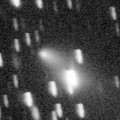
|
It brightened up to 13.6 mag in summer (July 16, Mitsunori Tsumura). Now it is 16.2 mag (Dec. 27, ATLAS-MLO, Mauna Loa). It will fade out rapidly after this. It will be fainter than 18 mag in February. In the Northern Hemisphere, it stays observable in good condition. In the Southern Hemisphere, it will never be observable after this.
Date(TT) R.A. (2000) Decl. Delta r Elong. m1 Best Time(A, h)
Dec. 23 23 31.90 64 38.5 1.976 2.463 107 16.6 18:23 (168, 59)
Dec. 30 23 42.64 64 5.1 2.063 2.511 105 16.8 18:27 (164, 59)
|
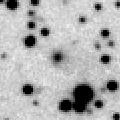
|
Now it is 16.8 mag (Dec. 8, Ken-ichi Kadota). It stays 17 mag for a while. In the Northern Hemisphere, it stays observable in good condition. It stays extremely low in the Southern Hemisphere.
Date(TT) R.A. (2000) Decl. Delta r Elong. m1 Best Time(A, h)
Dec. 23 4 39.84 41 38.5 5.786 6.690 154 16.6 22:33 (180, 83)
Dec. 30 4 37.28 41 30.3 5.822 6.689 149 16.7 22:03 (180, 83)
|

|
Now it is 16.7 mag (Dec. 17, A. Diepvens). It stays 17 mag for a while. In the Northern Hemisphere, it stays observable in good condition. It locates somewhat low in the Southern Hemisphere. But it will become high in autumn.
Date(TT) R.A. (2000) Decl. Delta r Elong. m1 Best Time(A, h)
Dec. 23 4 43.51 34 48.9 4.186 5.118 159 16.7 22:37 ( 0, 90)
Dec. 30 4 40.43 34 5.2 4.204 5.100 153 16.7 22:06 ( 0, 89)
|
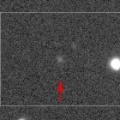
|
It will be observable at 15-16 mag from 2024 to 2025. Now it is 17.6 mag (Dec. 8, Toshihiko Ikemura, Hirohisa Sato). Brightening slowly. In the Northern Hemisphere, it stays observable in good condition. In the Southern Hemisphere, it will be getting higher gradually.
Date(TT) R.A. (2000) Decl. Delta r Elong. m1 Best Time(A, h)
Dec. 23 12 59.31 2 26.8 3.866 3.785 77 16.9 5:34 (325, 52)
Dec. 30 13 4.09 2 7.0 3.747 3.770 83 16.8 5:36 (335, 55)
|
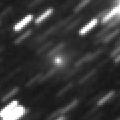
|
Very far object. Now it is 16.8 mag (Dec. 14, ATLAS Chile). It stays 17 mag for a while. In the Northern Hemisphere, it is not observable now. In the Southern Hemisphere, it stays observable in good condition.
Date(TT) R.A. (2000) Decl. Delta r Elong. m1 Best Time(A, h)
Dec. 23 2 48.63 -75 39.4 10.501 10.315 76 16.8 20:40 ( 0,-21)
Dec. 30 2 38.54 -74 58.4 10.525 10.316 75 16.8 20:03 ( 0,-20)
|

|
It approached to Earth down to 0.29 a.u. in early February, and it brightened up to 4.5 mag (Feb. 1, Juan Jose Gonzalez). Now it is 17.2 mag (Dec. 15, Jean-Claude Merlin). Fading slowly. It will be fainter than 18 mag in March. In the Northern Hemisphere, it will never be observable after this. In the Southern Hemisphere, it stays observable in good condition.
Date(TT) R.A. (2000) Decl. Delta r Elong. m1 Best Time(A, h)
Dec. 23 3 49.79 -62 2.1 4.434 4.550 90 16.8 21:41 ( 0, -7)
Dec. 30 3 36.68 -61 14.0 4.542 4.620 88 16.9 21:01 ( 0, -6)
|
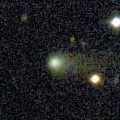
|
It brightened up to 13.9 mag in early 2023 (Jan. 21, Hidenori Nohara). Now it is 18.7 mag (Dec. 8, Toshihiko Ikemura, Hirohisa Sato). It stays 17 mag for a while. In the Northern Hemisphere, it stays observable in good condition. In the Southern Hemisphere, it will be getting higher gradually.
Date(TT) R.A. (2000) Decl. Delta r Elong. m1 Best Time(A, h)
Dec. 23 14 13.43 6 26.4 4.794 4.440 63 16.9 5:34 (299, 44)
Dec. 30 14 19.17 6 22.8 4.742 4.480 68 16.9 5:36 (306, 48)
|
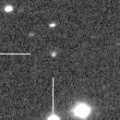
|
Now it is 18.2 mag (Dec. 24, ATLAS Chile). It stays 17 mag for a while. It locates somewhat low in the Northern Hemisphere. But it will become high in summer. In the Southern Hemisphere, it stays observable in good condition.
Date(TT) R.A. (2000) Decl. Delta r Elong. m1 Best Time(A, h)
Dec. 23 13 14.90 -24 20.8 3.786 3.484 64 17.0 5:34 (335, 26)
Dec. 30 13 23.24 -25 6.9 3.691 3.475 69 16.9 5:36 (341, 27)
|
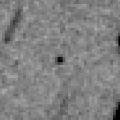
|
Now it is 17.3 mag (Dec. 25, ATLAS-HKO, Haleakala). It stays 17 mag for a while. In the Northern Hemisphere, it stays observable in good condition. It stays extremely low in the Southern Hemisphere. But it will become high in spring.
Date(TT) R.A. (2000) Decl. Delta r Elong. m1 Best Time(A, h)
Dec. 23 7 44.12 35 49.9 0.843 1.783 154 17.1 1:41 (180, 89)
Dec. 30 7 42.62 36 53.0 0.801 1.756 159 17.0 1:12 (180, 88)
|
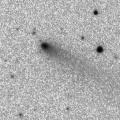
|
Now it is 16.5 mag (Dec. 13, Toshihiko Ikemura, Hirohisa Sato). It stays 18 mag for a while. In the Northern Hemisphere, it will be getting lower gradually. In the Southern Hemisphere, it will be getting lower gradually after this, and it will be unobservable in March.
Date(TT) R.A. (2000) Decl. Delta r Elong. m1 Best Time(A, h)
Dec. 23 0 10.70 -5 39.0 3.745 3.866 89 17.0 18:23 ( 7, 49)
Dec. 30 0 14.15 -4 58.8 3.866 3.882 83 17.1 18:27 ( 18, 49)
|

|
It brightened up to 14.1 mag in 2022 spring (Mar. 22, 2022, Chris Wyatt). Now it is 16.8 mag (Dec. 13, Toshihiko Ikemura, Hirohisa Sato). It stays 18 mag for a while. In the Northern Hemisphere, it will be getting lower gradually. In the Southern Hemisphere, it will be getting lower gradually after this, and it will be unobservable in March.
Date(TT) R.A. (2000) Decl. Delta r Elong. m1 Best Time(A, h)
Dec. 23 1 21.25 0 3.7 5.504 5.884 108 17.1 19:15 ( 0, 55)
Dec. 30 1 19.03 0 34.0 5.670 5.932 100 17.1 18:45 ( 0, 56)
|
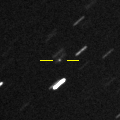
|
It brightens up to 16 mag from January to February. Now it is 16.8 mag (Dec. 16, Hidenori Nohara). It stays 17 mag for a while. It stays observable in good condition.
Date(TT) R.A. (2000) Decl. Delta r Elong. m1 Best Time(A, h)
Dec. 23 9 12.45 2 3.5 1.128 1.910 129 17.3 3:09 ( 0, 57)
Dec. 30 9 13.38 -0 27.9 1.060 1.885 134 17.1 2:42 ( 0, 55)
|
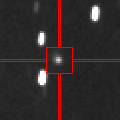
|
Now it is 16.9 mag (Dec. 22, ATLAS Chile). It stays 17 mag for a while. In the Northern Hemisphere, it will be unobservable in April. In the Southern Hemisphere, it stays observable in good condition.
Date(TT) R.A. (2000) Decl. Delta r Elong. m1 Best Time(A, h)
Dec. 23 4 55.60 -40 44.2 7.268 7.720 113 17.1 22:48 ( 0, 14)
Dec. 30 4 53.07 -40 24.2 7.270 7.696 112 17.1 22:18 ( 0, 15)
|

|
First return of a new periodic comet which brightened up to 10 mag in 2001. It is expected to brighten up to 12-13 mag from February to March in 2024. Now it is 16.7 mag (Dec. 21, Ken-ichi Kadota). It will brighten rapidly after this. In the Northern Hemisphere, it will be getting lower gradually. But it will be getting higher again after April. In the Southern Hemisphere, it will be unobservable in January.
Date(TT) R.A. (2000) Decl. Delta r Elong. m1 Best Time(A, h)
Dec. 23 23 8.98 -9 7.2 1.607 1.640 74 17.2 18:23 ( 27, 42)
Dec. 30 23 12.23 -4 52.6 1.649 1.596 69 17.1 18:27 ( 38, 43)
|

|
It is expected to brighten up to 13 mag in early summer in 2024. Now it is 17.0 mag (Dec. 22, ATLAS Chile). Brightening gradually. It locates somewhat low in the Northern Hemisphere. In the Southern Hemisphere, it will be getting lower gradually after this, and it will be unobservable in April. At the high light, it is not observable in the Southern Hemisphere, or it locates low in the Northern Hemisphere.
Date(TT) R.A. (2000) Decl. Delta r Elong. m1 Best Time(A, h)
Dec. 23 2 23.66 -40 8.5 2.241 2.578 98 17.4 20:17 ( 0, 15)
Dec. 30 2 15.38 -37 15.7 2.223 2.499 94 17.2 19:41 ( 0, 18)
|

|
Fading slowly. It will be fainter than 18 mag in January. In the Northern Hemisphere, it will be getting lower gradually. It stays extremely low in the Southern Hemisphere.
Date(TT) R.A. (2000) Decl. Delta r Elong. m1 Best Time(A, h)
Dec. 23 22 10.58 10 6.4 1.344 1.356 69 17.3 18:23 ( 60, 50)
Dec. 30 22 33.13 11 11.1 1.487 1.442 67 17.5 18:27 ( 64, 49)
|

|
It brightened up to 11.8 mag in summer (June 17, Osamu Miyazaki). Now it is 17.3 mag (Dec. 15, Catalina Sky Survey). Fading gradually. It will be fainter than 18 mag in January. In the Northern Hemisphere, it will be getting lower gradually. It stays extremely low in the Southern Hemisphere.
Date(TT) R.A. (2000) Decl. Delta r Elong. m1 Best Time(A, h)
Dec. 23 21 47.20 -0 39.1 2.964 2.598 59 17.4 18:23 ( 56, 38)
Dec. 30 21 58.51 0 0.6 3.068 2.629 54 17.6 18:27 ( 61, 35)
|

|
Now it is 17.5 mag (Dec. 11, ATLAS-MLO, Mauna Loa). It stays 18 mag for a while. In the Northern Hemisphere, it will be getting lower gradually. But it will be getting higher again after March. In the Southern Hemisphere, it is not observable now.
Date(TT) R.A. (2000) Decl. Delta r Elong. m1 Best Time(A, h)
Dec. 23 22 36.20 42 46.8 4.138 4.275 91 17.4 18:23 (118, 67)
Dec. 30 22 34.23 41 28.3 4.230 4.265 85 17.4 18:27 (114, 61)
|
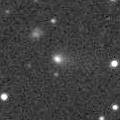
|
Now it is 16.5 mag (Dec. 8, Toshihiko Ikemura, Hirohisa Sato). Fading slowly. It will be fainter than 18 mag in January. It stays observable in good condition.
Date(TT) R.A. (2000) Decl. Delta r Elong. m1 Best Time(A, h)
Dec. 23 3 19.01 4 31.3 2.430 3.214 136 17.5 21:12 ( 0, 60)
Dec. 30 3 17.59 4 52.6 2.514 3.229 129 17.6 20:44 ( 0, 60)
|
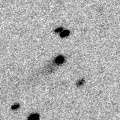
|
Now it is 17.5 mag (Dec. 16, ATLAS-MLO, Mauna Loa). It stays 18 mag for a while. In the Northern Hemisphere, it stays observable in good condition.
Date(TT) R.A. (2000) Decl. Delta r Elong. m1 Best Time(A, h)
Dec. 23 12 32.56 13 50.7 9.296 9.326 88 17.6 5:34 (326, 65)
Dec. 30 12 31.56 14 13.3 9.186 9.339 95 17.6 5:36 (344, 68)
|
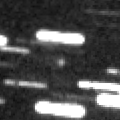
|
Now it is 17.5 mag (Dec. 14, Jean-Claude Merlin). It stays 18 mag for a while. It stays observable in good condition.
Date(TT) R.A. (2000) Decl. Delta r Elong. m1 Best Time(A, h)
Dec. 23 7 2.71 9 14.7 6.831 7.761 159 17.7 1:00 ( 0, 64)
Dec. 30 6 56.60 9 11.5 6.808 7.762 164 17.7 0:26 ( 0, 64)
|
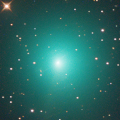
|
It brightened up to 8.4 mag in late July (July 22, Thomas Lehmann). Now it is 18.4 mag (Nov. 15, Toshihiko Ikemura, Hirohisa Sato). It will fade out rapidly after this. It locates somewhat low in the Northern Hemisphere. In the Southern Hemisphere, it will be getting lower gradually. Thomas Lehmann reported it was bright as 14.9 mag on Nov. 18.
Date(TT) R.A. (2000) Decl. Delta r Elong. m1 Best Time(A, h)
Dec. 23 23 48.75 -21 56.2 2.718 2.700 78 17.8 18:23 ( 11, 32)
Dec. 30 23 57.04 -21 8.3 2.885 2.777 73 18.1 18:27 ( 17, 32)
|
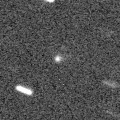
|
Now it is 17.1 mag (Dec. 13, Toshihiko Ikemura, Hirohisa Sato). It stays 17 mag for a while. In the Northern Hemisphere, it stays observable in good condition. In the Southern Hemisphere, it will be getting lower gradually.
Date(TT) R.A. (2000) Decl. Delta r Elong. m1 Best Time(A, h)
Dec. 23 1 22.06 -1 39.1 2.234 2.698 107 17.8 19:16 ( 0, 54)
Dec. 30 1 23.87 -1 1.0 2.289 2.661 101 17.8 18:50 ( 0, 54)
|

|
Now it is 17.2 mag (Dec. 19, ATLAS-MLO, Mauna Loa). Fading slowly. It will be fainter than 18 mag in January. In the Northern Hemisphere, it stays observable in good condition. In the Southern Hemisphere, it will never be observable after this.
Date(TT) R.A. (2000) Decl. Delta r Elong. m1 Best Time(A, h)
Dec. 23 21 59.97 76 17.3 1.486 1.995 106 17.9 18:23 (168, 45)
Dec. 30 22 47.94 76 38.4 1.477 1.997 106 17.9 18:27 (170, 46)
|

|
Now it is 18.2 mag (Dec. 26, Giuseppe Pappa). It stays 18 mag for a while. In the Northern Hemisphere, it stays observable in good condition. It locates somewhat low in the Southern Hemisphere.
Date(TT) R.A. (2000) Decl. Delta r Elong. m1 Best Time(A, h)
Dec. 23 4 37.05 23 5.0 3.195 4.135 160 17.9 22:30 ( 0, 78)
Dec. 30 4 33.33 22 45.2 3.239 4.136 152 17.9 21:59 ( 0, 78)
|

|
It brightened up to 13.4 mag in 2022 summer (July 7, 2022, Giuseppe Pappa). Now it is 18.6 mag (Oct. 2, ATLAS-HKO, Haleakala). It stays 18 mag for a while. In the Northern Hemisphere, it stays observable in good condition. In the Southern Hemisphere, it will never be observable after this.
Date(TT) R.A. (2000) Decl. Delta r Elong. m1 Best Time(A, h)
Dec. 23 16 13.38 32 50.0 5.636 5.246 61 17.9 5:34 (251, 34)
Dec. 30 16 17.16 33 46.8 5.626 5.296 65 17.9 5:36 (252, 39)
|

|
Now it is 17.5 mag (Dec. 26, Giuseppe Pappa). Fading slowly. It locates somewhat low in the Northern Hemisphere. It stays extremely low in the Southern Hemisphere. It was very faint as 21.5 mag in 2021. It seems to be bright temporarily in outburst.
Date(TT) R.A. (2000) Decl. Delta r Elong. m1 Best Time(A, h)
Dec. 23 21 40.68 -9 27.8 5.248 4.735 53 17.9 18:23 ( 50, 31)
Dec. 30 21 46.29 -8 58.9 5.348 4.749 48 18.0 18:27 ( 56, 27)
|

|
Now it is 18.5 mag (Dec. 21, Giuseppe Pappa). It stays 18 mag for a while. It stays observable in good condition.
Date(TT) R.A. (2000) Decl. Delta r Elong. m1 Best Time(A, h)
Dec. 23 11 46.08 8 7.1 1.775 2.130 96 18.0 5:34 (355, 63)
Dec. 30 11 54.07 7 3.8 1.697 2.128 101 17.9 5:23 ( 0, 62)
|
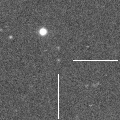
|
Far asteroid moving along a cometary orbit. It brightens up to 18 mag from 2024 to 2025. It stays 18 mag for a while. In the Northern Hemisphere, it stays observable in good condition. It stays extremely low in the Southern Hemisphere.
Date(TT) R.A. (2000) Decl. Delta r Elong. m1 Best Time(A, h)
Dec. 23 9 6.24 50 13.4 8.074 8.803 135 18.0 3:03 (180, 75)
Dec. 30 8 59.95 50 30.2 8.016 8.798 140 17.9 2:30 (180, 75)
|

|
First return of a new periodic comet which was discovered in 2011, half a year after the perihelion passage. It is expected to brighten up to 14.5 mag in spring. It will brighten rapidly after this. It stays observable in good condition. Maik Meyer pointed out the identification of Asteroid 2023 WM26 and this comet.
Date(TT) R.A. (2000) Decl. Delta r Elong. m1 Best Time(A, h)
Dec. 23 8 53.29 18 49.7 1.259 2.109 140 18.2 2:50 ( 0, 74)
Dec. 30 8 51.84 17 50.5 1.149 2.046 147 17.9 2:21 ( 0, 73)
|
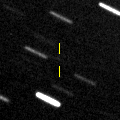
|
Now it is 19.9 mag (Dec. 22, Giuseppe Pappa). Fading slowly. It locates somewhat low.
Date(TT) R.A. (2000) Decl. Delta r Elong. m1 Best Time(A, h)
Dec. 23 22 30.96 -16 23.8 1.963 1.751 62 18.3 18:23 ( 34, 32)
Dec. 30 22 47.19 -14 19.2 2.016 1.751 60 18.3 18:27 ( 39, 32)
|
|
![]()
 29P/Schwassmann-Wachmann 1
29P/Schwassmann-Wachmann 1 C/2021 T4 ( Lemmon )
C/2021 T4 ( Lemmon ) C/2023 P1 ( Nishimura )
C/2023 P1 ( Nishimura ) C/2022 L2 ( ATLAS )
C/2022 L2 ( ATLAS ) C/2019 L3 ( ATLAS )
C/2019 L3 ( ATLAS ) C/2023 A3 ( Tsuchinshan-ATLAS )
C/2023 A3 ( Tsuchinshan-ATLAS ) C/2021 G2 ( ATLAS )
C/2021 G2 ( ATLAS ) 32P/Comas Sola
32P/Comas Sola C/2020 K1 ( PanSTARRS )
C/2020 K1 ( PanSTARRS ) 207P/NEAT
207P/NEAT C/2023 X1 ( Leonard )
C/2023 X1 ( Leonard ) C/2019 T4 ( ATLAS )
C/2019 T4 ( ATLAS ) C/2021 X1 ( Maury-Attard )
C/2021 X1 ( Maury-Attard ) 226P/Pigott-LINEAR-Kowalski
226P/Pigott-LINEAR-Kowalski 13P/Olbers
13P/Olbers 2P/Encke
2P/Encke 471P/2023 KF3
471P/2023 KF3 C/2014 UN271 ( Bernardinelli-Bernstein )
C/2014 UN271 ( Bernardinelli-Bernstein ) P/2007 T2 ( Kowalski )
P/2007 T2 ( Kowalski ) C/2022 JK5 ( PanSTARRS )
C/2022 JK5 ( PanSTARRS ) C/2022 S4 ( Lemmon )
C/2022 S4 ( Lemmon ) 213P/Van Ness
213P/Van Ness C/2022 V2 ( Lemmon )
C/2022 V2 ( Lemmon ) C/2022 A3 ( Lemmon-ATLAS )
C/2022 A3 ( Lemmon-ATLAS ) C/2023 S2 ( ATLAS )
C/2023 S2 ( ATLAS ) C/2021 Y1 ( ATLAS )
C/2021 Y1 ( ATLAS ) C/2022 A2 ( PanSTARRS )
C/2022 A2 ( PanSTARRS ) C/2023 S3 ( Lemmon )
C/2023 S3 ( Lemmon ) C/2023 C2 ( ATLAS )
C/2023 C2 ( ATLAS ) C/2022 QE78 ( ATLAS )
C/2022 QE78 ( ATLAS ) 126P/IRAS
126P/IRAS C/2021 S4 ( Tsuchinshan )
C/2021 S4 ( Tsuchinshan ) C/2022 U3 ( Bok )
C/2022 U3 ( Bok ) 65P/Gunn
65P/Gunn C/2019 E3 ( ATLAS )
C/2019 E3 ( ATLAS ) C/2022 E3 ( ZTF )
C/2022 E3 ( ZTF ) C/2020 S4 ( PanSTARRS )
C/2020 S4 ( PanSTARRS ) C/2022 T1 ( Lemmon )
C/2022 T1 ( Lemmon ) 227P/Catalina-LINEAR
227P/Catalina-LINEAR 117P/Helin-Roman-Alu 1
117P/Helin-Roman-Alu 1 C/2020 Y2 ( ATLAS )
C/2020 Y2 ( ATLAS ) 150P/LONEOS
150P/LONEOS C/2022 R6 ( PanSTARRS )
C/2022 R6 ( PanSTARRS ) P/2023 W1 ( NEAT )
P/2023 W1 ( NEAT ) C/2023 V4 ( Camarasa-Duszanowicz )
C/2023 V4 ( Camarasa-Duszanowicz ) (3200) Phaethon
(3200) Phaethon 237P/LINEAR
237P/LINEAR C/2022 U1 ( Leonard )
C/2022 U1 ( Leonard ) 170P/Christensen
170P/Christensen C/2020 F2 ( ATLAS )
C/2020 F2 ( ATLAS ) C/2021 A9 ( PanSTARRS )
C/2021 A9 ( PanSTARRS ) C/2023 E1 ( ATLAS )
C/2023 E1 ( ATLAS ) 30P/Reinmuth 1
30P/Reinmuth 1 C/2023 T2 ( Borisov )
C/2023 T2 ( Borisov ) 404P/2020 M6 ( Bressi )
404P/2020 M6 ( Bressi ) C/2020 R7 ( ATLAS )
C/2020 R7 ( ATLAS ) P/2023 M4 ( ATLAS )
P/2023 M4 ( ATLAS ) 216P/LINEAR
216P/LINEAR (468861) 2013 LU28
(468861) 2013 LU28 P/2011 NO1 ( Elenin )
P/2011 NO1 ( Elenin ) P/2018 P3 ( PanSTARRS )
P/2018 P3 ( PanSTARRS )![]()

































































